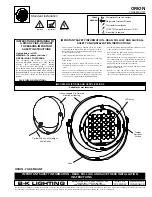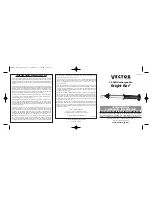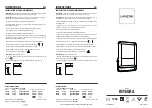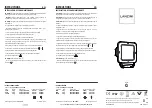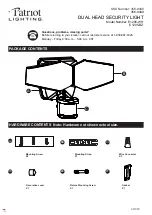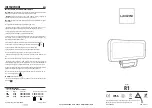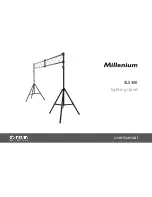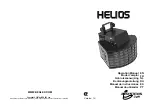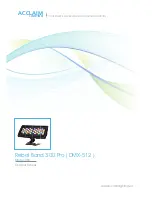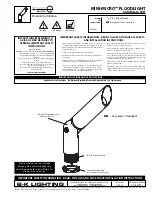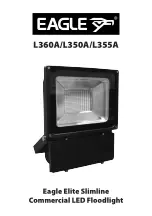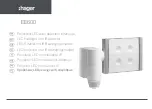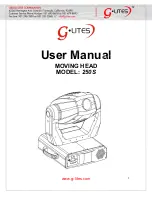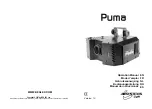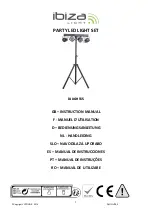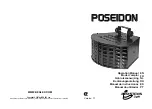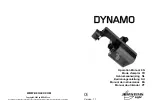
Flexible Floodlights
DW913 (9.6 V), DW917 (12 V), DW918 (14.4 V),
DW919 (18 V)
– Use with D
E
WALT power packs and chargers (both sold
separately).
IF YOU HAVE ANY QUESTIONS OR COMMENTS ABOUT
THIS OR ANY D
E
WALT TOOL, CALL US TOLL FREE AT:
1-800-4-D
E
WALT (1-800-433-9258)
NOTE:
Your DW913 flexible floodlight operates on a 9.6V power pack.
Your DW917 flexible floodlight operates on a 12V power pack. Your
DW918 flexible floodlight operates on a 14.4V power pack. Your DW919
flexible floodlight operates on a 18V power pack. Power packs are sold
separately.
WARNING:
To reduce the risk of injury, read the instruction
manual.
General Power Tool Safety Warnings
WARNING! Read all safety warnings and instructions
Failure
to follow the warnings and instructions may result in electric
shock, fire and/or serious injury.
SAVE ALL WARNINGS AND INSTRUCTIONS
FOR FUTURE REFERENCE
The term “power tool” in the warnings refers to your mains-operated
(corded) power tool or battery-operated (cordless) power tool.
Safety Rules for Flexible Floodlights
WARNING:
DO NOT OPERATE FLASHLIGHT or charger
NEAR FLAMMABLE LIQUIDS OR IN GASEOUS OR EXPLOSIVE
ATMOSPHERES. INTERNAL SPARKS MAY IGNITE FUMES. Do not
expose Flexible floodlight or charger to rain or damp areas.
WARNING:
Lens and bulb become hot during use.
•
During or immediately after use, don’t lay flexible floodlight flat on
lens surface.
•
Don’t touch lens surface when bulb is lit or immediately after use.
•
Handle flexible floodlight with care around any flammable
surface.
•
If bulb has been lit, let flexible floodlight cool for several minutes
before changing bulb.
Important Safety Instructions for All
Battery Chargers
• Before using charger, read all instructions and cautionary markings
on charger, battery pack, and product using battery pack.
DANGER:
Electrocution hazard. 120 volts are present at charging
terminals. Do not probe with conductive objects. Electric shock or
electrocution may result.
DANGER:
Electrocution hazard. Never attempt to open the battery
pack for any reason. If battery pack case is cracked or damaged, do
not insert into charger. Do not crush, drop or damage battery pack. Do
not use a battery pack or charger that has received a sharp blow, been
dropped, run over or damaged in any way (i.e., pierced with a nail,
hit with a hammer, stepped on). Electric shock or electrocution may
result. Damaged battery packs should be returned to service center for
recycling.
•
DO NOT attempt to charge the battery pack with any chargers
other than the ones in this manual.
The charger and batter y pack
are specifically designed to work together.
•
Do not expose charger to rain or snow.
•
Pull by plug rather than cord when disconnecting charger.
This
will reduce risk of damage to electric plug and cord.
•
Make sure that cord is located so that it will not be stepped on,
tripped over, or otherwise subjected to damage or stress.
•
Do not use an extension cord unless it is absolutely necessary.
Use of improper extension cord could result in risk of fire, electric
shock, or electrocution.
•
Two wire cords can be used with 2 or 3 wire extension cords. Only
round jacketed extension cords should be used, and we recommend
that they be listed by Underwriters Laboratories (U.L.) (C.S.A. in
Canada.) The letters WA on the cord jacket indicate that the cord is
suitable for outdoor use.
•
An extension cord must have adequate wire size (AWG or
American Wire Gauge) for safety.
The smaller the gauge number
of the wire, the greater the capacity of the cable, that is 16 gauge has
more capacity than 18 gauge. An undersized cord will cause a drop
in line voltage resulting in loss of power and overheating. When using
more than one extension to make up the total length, be sure each
individual extension contains at least the minimum wire size. The
following table shows the correct size to use depending on cord length
and nameplate ampere rating. If in doubt, use the next heavier gauge.
The smaller the gauge number, the heavier the cord.
Recommended Minimum Wire Size for Extension Cords
Total Length of Cord
25 ft.
50 ft.
75 ft.
100 ft.
125 ft.
150 ft.
175 ft.
7.6 m 15.2 m
22.9 m 30.5 m 38.1 m 45.7 m
53.3 m
Wire Size
AWG
18 18 16 16 14 14 12
•
Do not place any object on top of charger or place the charger
on a soft surface that might block the ventilation slots and
result in excessive internal heat.
Place the charger in a position
away from any heat source. The charger is ventilated through slots
in the top and the bottom of the housing.
•
Do not operate charger with damaged cord or plug
.
•
Do not operate charger if it has received a sharp blow, been
dropped, or otherwise damaged in any way.
Take it to an
authorized service center.
•
Do not disassemble charger; take it to an authorized service
center when service or repair is required.
Incorrect reassembly
may result in a risk of electric shock, electrocution or fire.
•
Disconnect the charger from the outlet before attempting any
cleaning. This will reduce the risk of electric shock.
Removing
the battery pack will not reduce this risk.
•
NEVER
attempt to connect 2 chargers together.
• Do not store or use the tool and battery pack in locations where
the temperature may reach or exceed 105°F (40˚C) (such as
outside sheds or metal buildings in summer).
•
The charger is designed to operate on standard 120V household
electrical power. Do not attempt to use it on any other voltage.
This does not apply to the vehicular charger.
Important Safety Instructions for All
Battery Packs
SPECIFIC SAFETY INSTRUCTIONS FOR NICKEL CADMIUM
(NiCd) OR NICKEL METAL HYDRIDE (NiMH)
•
Do not incinerate the battery pack even if it is severely damaged
or is completely worn out.
The battery pack can explode in a fire.
•
A small leakage of liquid from the battery pack cells may occur
under extreme usage or temperature conditions.
This does not
indicate a failure.
However, if the outer seal is broken:
a. and the battery liquid gets on your skin, immediately wash with
soap and water for several minutes.
b. and the battery liquid gets into your eyes, flush them with clean
water for a minimum of 10 minutes and seek immediate medical
attention. (
Medical note:
The liquid is 25-35% solution of
potassium hydroxide.)
SPECIFIC SAFETY INSTRUCTIONS FOR LITHIUM ION (LI-ION)
•
Do not incinerate the battery pack even if it is severely
damaged or is completely worn out.
The battery pack can
explode in a fire. Toxic fumes and materials are created when
lithium ion battery packs are burned.
•
If battery contents come into contact with the skin,
immediately wash area with mild soap and water.
If battery
liquid gets into the eye, rinse water over the open eye for
15 minutes or until irritation ceases. If medical attention is needed,
the battery electrolyte is composed of a mixture of liquid organic
carbonates and lithium salts.
•
Contents of opened battery cells may cause respiratory
irritation.
Provide fresh air. If symptoms persists, seek medical
attention.
WARNING:
Burn hazard. Battery liquid may be flammable if exposed
to spark or flame.








